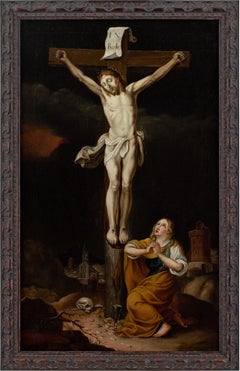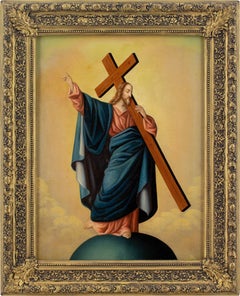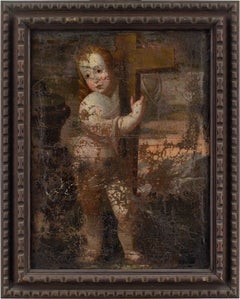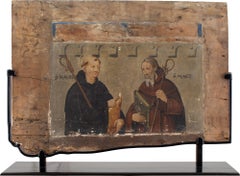Items Similar to Early 18th-Century Russian Icon, Volga Masters (Circle), The Crucifixion
Want more images or videos?
Request additional images or videos from the seller
1 of 8
UnknownEarly 18th-Century Russian Icon, Volga Masters (Circle), The Crucifixionc. 1720
c. 1720
$2,867.68
£2,090
€2,445.90
CA$4,000.35
A$4,339.47
CHF 2,281.94
MX$52,802.61
NOK 28,527.89
SEK 26,905.31
DKK 18,261.77
About the Item
This exquisite and exceedingly rare early 18th-century Russian Staurotek icon depicts The Crucifixion of Christ with an assemblage of saints, together with a 19th-century copper-cast eight-pointed cross, inserted in the central recess.
Due to the exceptional nature of this piece, we consulted Ilya Kushnirskiy, the Director of the Russian Icon Collection, who in turn contacted Anastasia V. Likhenko, Curator at the State Tretyakov Gallery, Moscow. Ms Likhenko kindly provided a detailed essay, in which she concluded that “this Staurotek, with its copper-cast cross, possesses significant historical, artistic, and collector's value.” Her paper will be included with the sale.
Staurotek icons, also known as Staurotheke, are specific to Eastern Orthodox Christianity and often depict a Crucifixion scene, with an elaborately decorated cross set within the image. Popular during the 18th and 19th centuries, metal icons offered both portability and durability, enabling the owner to carry a token of their faith at all times. They often survived continual use and, as such, were passed down through generations of the same family.
Here, in this early example, the figures are especially finely rendered and include, from left to right, a woman in a pink maphorion, the Mother of God, St. John the Theologian in a pink himation, and St. Longinus in a silver armour and a green tunic. They’re standing before a view of Jerusalem, and beneath a greenish sky with two seraphim and ‘luminaries’ (the sun and moon). It’s extraordinary that the original gilding is still present on the robes of the saints and the wings of the seraphim, while the armour of St. Longinus retains its original silver.
The cross itself is cast in copper and depicts Christ’s crucifixion with various associated symbolism. Above, is the image of God, together with a dove, to represent the Holy Spirit. At the foot lies the skull of Adam. The various inscriptions have been translated in Ms Likhenko’s paper, which also contains an attribution as follows:
“The elegance of proportions, the incredible subtlety of the painting, and the unique work with gold and silver indicate that the master who painted the scene of the Crucifixion from this Stavroteka was well acquainted with high-class examples of the Volga, and possibly Moscow art (for example, the Yaroslavl icon of the Crucifixion from the middle of the 17th century in the Andrei Rublev Museum, Moscow, or the Yaroslavl Crucifixion from the 1680s in a private collection, Moscow).”
Medium: Tempera on wood with silver and gilt
Provenance: With Richardson & Kailas, Specialist in Icons (2001) / Private collection, UK.
Our reference: BRV2091
- Creation Year:c. 1720
- Dimensions:Height: 11 in (27.94 cm)Diameter: 6 in (15.24 cm)
- Medium:
- Movement & Style:
- Period:1720-1729
- Condition:Cleaned. Areas of fine and settled craquelure. The paint layer is stable. Various scuffs, abrasions and losses as expected given its use.
- Gallery Location:Cheltenham, GB
- Reference Number:1stDibs: LU2328216351652
About the Seller
5.0
Platinum Seller
Premium sellers with a 4.7+ rating and 24-hour response times
Established in 2017
1stDibs seller since 2023
246 sales on 1stDibs
Typical response time: <1 hour
- ShippingRetrieving quote...Shipping from: Cheltenham, United Kingdom
- Return Policy
Authenticity Guarantee
In the unlikely event there’s an issue with an item’s authenticity, contact us within 1 year for a full refund. DetailsMoney-Back Guarantee
If your item is not as described, is damaged in transit, or does not arrive, contact us within 7 days for a full refund. Details24-Hour Cancellation
You have a 24-hour grace period in which to reconsider your purchase, with no questions asked.Vetted Professional Sellers
Our world-class sellers must adhere to strict standards for service and quality, maintaining the integrity of our listings.Price-Match Guarantee
If you find that a seller listed the same item for a lower price elsewhere, we’ll match it.Trusted Global Delivery
Our best-in-class carrier network provides specialized shipping options worldwide, including custom delivery.More From This Seller
View AllEarly 18th-Century Flemish School, Christ On The Cross With Mary Magdalene
Located in Cheltenham, GB
This early 18th-century Flemish oil painting depicts Christ on the cross with a sorrowful Mary Magdalene and Jerusalem beyond.
Head bloodied by a crown of thorns, arms taut and wrac...
Category
1720s Flemish School Figurative Paintings
Materials
Oil, Canvas
Early 19th-Century Central European School, Christ The Saviour
Located in Cheltenham, GB
This early 19th-century central European oil painting depicts Christ The Saviour standing atop an orb and carrying a cross over his left shoulder.
An unusual composition, Christ’s rather striking posture is perhaps more ‘Saturday Night Fever’ than it is sacramental. However, the iconography is archaic and derived ultimately from New Testament illustrations dating to the Middle Ages. Depictions of orbs are usually symbolic of the universe, while the cross alludes to redemption. Hence, it’s a visual representation of Christ as the Saviour of humanity.
Francisco de Zurbarán...
Category
1830s Portrait Paintings
Materials
Oil, Canvas
18th-Century Spanish School, Child Jesus Embracing The Cross
Located in Cheltenham, GB
This early 18th-century Spanish oil painting depicts an infant Jesus clutching a cross before a landscape.
Dressed in a flowing white robe, as a symbolic reference to purity, the ch...
Category
Early 18th Century Old Masters Figurative Paintings
Materials
Canvas, Oil
Late 16th-Century Catalan School, Saint Magí & Saint Mauro
Located in Cheltenham, GB
This remarkable late 16th-century fragment depicts Saint Magí, the patron saint of Tarragona, and Saint Mauro, a Benedictine monk. Produced in around 1580, on the cusp of the Anglo-S...
Category
16th Century Figurative Paintings
Materials
Metal
18th-Century Venetian School, Mary Magdalene, Noli Me Tangere
Located in Cheltenham, GB
This late 18th-century Italian oil painting fragment depicts Mary Magdalene kneeling alongside an alabaster jar. Christ’s hand is partially visible above, along with his robes, which...
Category
18th Century Italian School Figurative Paintings
Materials
Oil, Canvas
Late 16th-Century, Italian School Saint Jerome The Penitent, Religious Art
Located in Cheltenham, GB
This late 16th-century Italian School oil on copper depicts Saint Jerome in penitence, contemplating Christ’s crucifixion, while holding a stone to his chest, with a landscape beyond...
Category
16th Century Baroque Figurative Paintings
Materials
Copper
You May Also Like
18th Century Traditional Russian Icon
Located in Los Angeles, CA
Traditional Russian icon made in the 18th century, depicting the crucifixion of Jesus who is surrounded by various saints such as St. Boniface and St. Nicholas on the top. It also in...
Category
Antique 18th Century Russian Paintings
Materials
Wood
18th/19th Century Russian Quadripartite Icon
Located in Los Angeles, CA
Quadripartite tempera on wood icon of the Crucifixion of Jesus in the center surrounded by holy scenes; depicting the Mother of God of Kazan...
Category
Antique 19th Century Russian Paintings
Materials
Wood
Antique Russian Orthodox Icon St. Helena & Constantine Marcarius True Cross 1820
Located in Portland, OR
A fine & large antique Russian Orthodox icon, circa 1820.
This large antique Russian icon painted with egg tempera on wooden panel, depicts the "True Cross" to the center with Saint...
Category
Antique 1820s Russian Revival Paintings
Materials
Wood, Paint
18th Century Eastern Orthodox Tempera Icon
Located in Dekalb, IL
Antique tempera Icon depicting St. John the Baptist holding his own head, a reference to his execution by beheading. This came as a result of John publicl...
Category
Antique 17th Century Greek Renaissance Paintings
Materials
Tin
Large Early 18th Century Russian Icon of Veneration of St. Michael
Located in Los Angeles, CA
Large religious icon made in Russia in the early 18th century depicting the Veneration of St. Michael. He is shown surrounded by Saints and Prophets. They are painted delicately in t...
Category
Antique Early 18th Century Russian Paintings
Materials
Wood, Paint
Large Antique Russian Icon Resurrection and Great Feast Days, 18th-19th Century
Located in New York, NY
Large antique late 18th century- early 19th century Russian icon of the Resurrection with Great Feasts. Original condition with beautiful age-old patina. The central area depicting t...
Category
Antique Late 18th Century Russian Religious Items
Materials
Wood
More Ways To Browse
Antique Icons
The Crucifixion
Russian Icon
Antique Orthodox
Antique Icon Painting
Antique Russian Paintings
19th Century Icon
Holy Spirit
Crucifixion Paintings
Antique Russian Icon
Century Russian Icon
Tempera On Wood
Russian Icon Painting
18th Century Icon
Copper Cross
Christ Of Saint John Of The Cross
Russian Icon Mother Of God
18th Century Russian Icon



